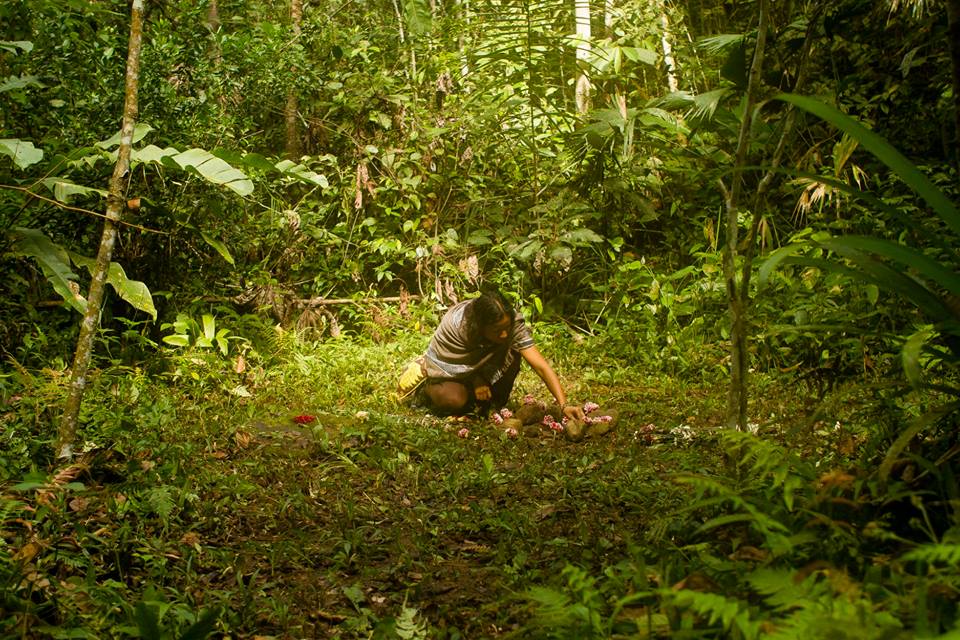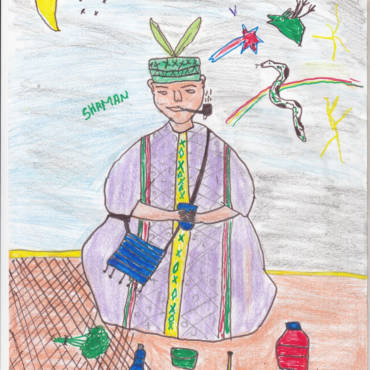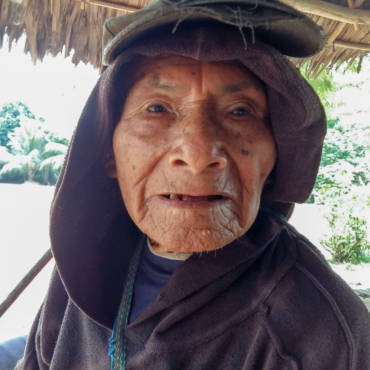Woman – The Sacred Feminine
Woman – The Sacred Feminine
Rituals of Transition
A type of ritual exists In different indigenous tribes in which girls and boys take part in a ceremony to help them with the the change that occurs when they are about to transform from children into adults. These rituals were of great importance in these communities, since they were moments when a girl received all information, advice, and wisdom from the older women in order to know the changes the occurred in her body and in her life, to become conscious of the importance of taking care of her body and of her personal habits, to be able to relate positively to the nature of her body in order to transform into a healthy woman, strong, a good wife, good mother and capable of taking care of her family and the community.

Whereas different indigenous groups around the world have similar rituals for these moments, they also have differences, depending on the unique traditional wisdom. In North America, the Lakota had a ritual called “Isna ti ca lowan,” which means “Song of Isolation,” in which a girl received her first menstruation. She was taken to a cabinet isolated from the rest of the community, where she spent four days and four nights, receiving instructions from the grandmothers and from a godmother, chosen in advance, who taught her Quillwork, how to make moccasins, and all kinds of handicrafts and artistry. She was supposed to do something with her hands all of the time, and if something turned out badly, she was not supposed to break it, because if she did, she would be this way for the rest of her life with all things. If something turned out badly, she was supposed to finish it and do a better job the next time. This taught her persistence and self-confidence. The girls were also shown how to make quilts sown out of pieces of different cloth, so that they would understand saving and worth, beauty, and hard work. They were taught to cook in order to show hospitality, and all useful things like how to put hot stones in bags made from stomachs from buffalo in order to cook soup on top, and how to grind and crush seeds with stones. The girl was not allowed to look outside the window, or to stay by the door to spy, and she was not supposed to scratch her head or any other part of her body. During those days, she was not supposed to have a bad mood or to to have bad thoughts about anything or anyone, and to try to be happy and not to get angry, otherwise she would be like this for the rest of her life.
It was the wise grandmothers who were in charge of delivering the message of the White Buffalo Woman to the women. It is very true that in the old times, it was the woman who earned and kept the prestige and status of the family. Her hard work, cleanliness, honesty, humor, wisdom, courage, and generosity raised the family worth in the eyes of people. The Lakota woman was also in charge of the barter goods and used them, exchanged them, or disposed of them in her best interest.
The godmother was a woman of wisdom and highly respected. She prayed for the girl every day, smudging with sage and cedar, praying to the spirits of all four directions, asking for help for the girl to become a good woman who would treat her visitors with hospitality, be hardworking, and would pray to Wakan Tanka (the Great Spirit) and to Maka Ina (Mother Earth) and to all the ancestors asking for help to be a good mother, and that all the food that she cooked throughout her life would be good for the people who ate it, and for her to be a good wife and to live with the same man for her whole life, and that she would be blessed with healthy children. During these special days, the Grandmother told the girl that everything in this life is sacred, that she should never curse, complain, or anything similar because these things, although they might displease her, were created with a purpose. Everything is sacred. During these four days, the Grandmother taught her to always thank Wakan Tanka for all things given to us, to be thankful for our health, and to never forget to pray when in a problem or in need of anything.
In the Sierra Nevada of Santa Marta in Colombia, the Kogui still practice a ritual of transition.
The girls and boys of this tradition dress the same way (in general a white tunic or dress) until the moment comes when their bodies start to change to become men and women. The children are not forewarned of these changes until shortly beforehand, when the adults observe that this moment is approaching, and the girl is told that a bat will soon bite her. And when the first bleeding arrives, she is isolated for four days in a Maloca (a ceremonial cabin) together with her mother and the Saka (the Wise Grandmother Medicine Woman) of the community. During these four days she must knit various bags. These are knit in a spiral design until they form a small bag, which resembles the form of a uterus, a container, and also represents the cosmos. These bags are used to keep sacred objects. While she knits, she should keep good thoughts. At the same time, she receives advice from the older women on how to relate to her body, how to be a woman, how to choose a husband, become a woman, always to take care of herself, her words and her knitting, among many other things.
After these four days, she is taken to a river where her mother bathes her with plants and she receives the traditional dress, a belt and a necklace with red beads. All of the bags that she knit during those days are taken to the Mama (the Wise Man Authority) of the community. He studies the knitting of the the youth to foretell if she will be a good woman, hardworking, responsible, a good mother, capable of caring for her family and the community etc. The Kogui repeat this ritual one month later, when the bleeding returns.
The first drops of the first bleeding are collected on a small piece of cotton which is kept throughout her life, and which she carries in a small knit bag just for this purpose, to help the girl providing strength and protection. For the Kogui, the cotton plant is one of the most sacred because from it the ancestral mother derives the thread to weave life, they weave their bags and all of their clothes, make payments, and the women also use this cotton to collect their menstruation.
The rest of her blood, from the first month and for the rest of her life, is gifted to the earth, always in the same place, en a place she chooses, which she converts in her sacred altar, where she gives offerings, and where she will take the umbilical cord and placenta of her children, where she can retreat to and pray.
The Kogui women always keep small cotton balls with a little bit of their mens blood. They use them for offerings, healings, or they give them to the Mama or the Saka of the community for special payments. Also, when the women receive their last mens, they join some of this last blood with some of the first, and this object then becomes something very sacred, granting much protection and it is very powerful for the women.
In the Department of Cauca in Colombia, Pi Urek (children of the water) also have a ritual of transition that is very important for the girls and boys in the community. In this town, the first menstruation is referred to as “flowering,” when the girl stops being a button and opens up like a flower and begins to offer her blood to the earth. When the girl begins to “flower,” she is taken to a cabin called “Chimineya” for four days. During this time she receives attention, care, and special food cooked by her mother and other women in the family. They keep a special diet without salt, for example cooked potatoes and boiled eggs and roasted corn with cane sugar. Everything she eats must be sweet and she drinks infusions from special plants with cane sugar. A special bed is prepared from medicinal plants that keeps bleeding from being abundant, prevents pain, and keeps her from becoming lazy, so that she stays strong and healthy. She sits on this bed while she weaves and knits. These plants also absorb all of her blood, which is also always offered to the same place. Throughout her life she takes her blood to this place. When the moment of her last menstruation arrives, this hole in the earth is closed and another ritual is done to close the circle.
The girl must weave and knit a total of 12 pieces (bags, hats, skirts, etc.) At the end of four days, her mother bathes her with plants like sage, rue, feverfew, and peppermint after which she receives a visit from the traditional doctor who does a spiritual cleanse called “refreshing.” The next day they take the girl to the river where seated on a rock with her back to the river, she throws all of her pieces to the water, symbolizing her laziness and anger, and all of the bad things that happened to her as a girl, so that the river takes them and she can rid herself of them forever. After this, she has to cook and make coffee for all of the family. She does this all by herself, including serving the plates, and serving equal and abundant portions for everyone. There should be enough food for everyone, and more so that the older ones can tell if her life will be abundant and productive.
For the Pi Urek people, this ritual also serves to strengthen the body, preventing sickness, and also as a spiritual prevention from becoming pregnant too early on. They do not use disposable pads, tampons, or menstrual cups. They say that the blood must flow outside of the body since it is hot. The plastic prevents the heat from coming out which stays in the body as a kind of vapor and probably causes serious sickness like cancer. They only use cotton, which allows for the heat to leave the body. Also, this cloth can be washed and reused so as not to be wasteful.
In Mexico, the Huicholes of Wixarica also have a ritual for this moment when the girl receives her first menstruation. The mother cuts four strands of hair from the forehead, neck, left and right side of the head. This is so that the bleeding does not arrive too strong, and to offer this hair to the place where her umbilical cord lays.
Today’s woman has habits and customs in which she acts in a way that is mostly or completely disconnected from her feminine nature. In a patriarchal world, woman has been taught to relate to her menstruation in a negative way, with dislike. We have learned to ignore, or we have been advised to stop the menstrual flow which is seen as something uncomfortable. When we have our days of bleeding, we are much more perceptive and sensitive, and for this reason we should take the time to retreat and seek calm, which is mostly impossible for many woman today, as it is to offer our blood to the earth. For this reason, we should try during these days to take at least one hour to be by ourselves, to avoid heavy work and to reduce our socializing. When we fail to respect our body is when we suffer discomfort such as stomach pains and headaches, or bad moods. There are some other important things to note on these days for example what we eat, the temperature of the body, and how to relate to our blood in a natural way without thinking that it is something to hide or be ashamed of.
Propaganda tells us that the blood is blue, and that there are many ways to “normalize” during these days with sports, swimming, work, or socializing. We have been taught that our blood is dirty and disgusting, to be thrown away in the trash while at the same time polluting the earth with plastic sanitary napkins.
Our mother earth is very sad because women fail to recognize her as a mother, and we fail to offer her our blood and on top of that we dirty her by spreading trash. Besides causing a disconnect with our feminine nature and various discomforts, this has brought am imbalance in the harmony of life that only women can fix. Mother earth is receiving much blood through violence, war and assassination. We should compensate this bloodshed with our live giving blood. This honors the virtue of the sacred feminine because this is the way that our body reminds us every month that we are capable of creating life, and that this is the blood from which we all come from. The women of today have not received these teachings nor have we engaged in these types of rituals. This is because our mothers and grandmothers also failed to get this information. This knowledge is being lost because of a patriarchal society, religion, and because of the need of many women to work outside the home for example. And we can not start living a life similar to that of small traditional villages, but we can learn from them in order to find our own way of reconnecting with our nature and of helping to reestablish the harmony of life.
By: Mara Velez


